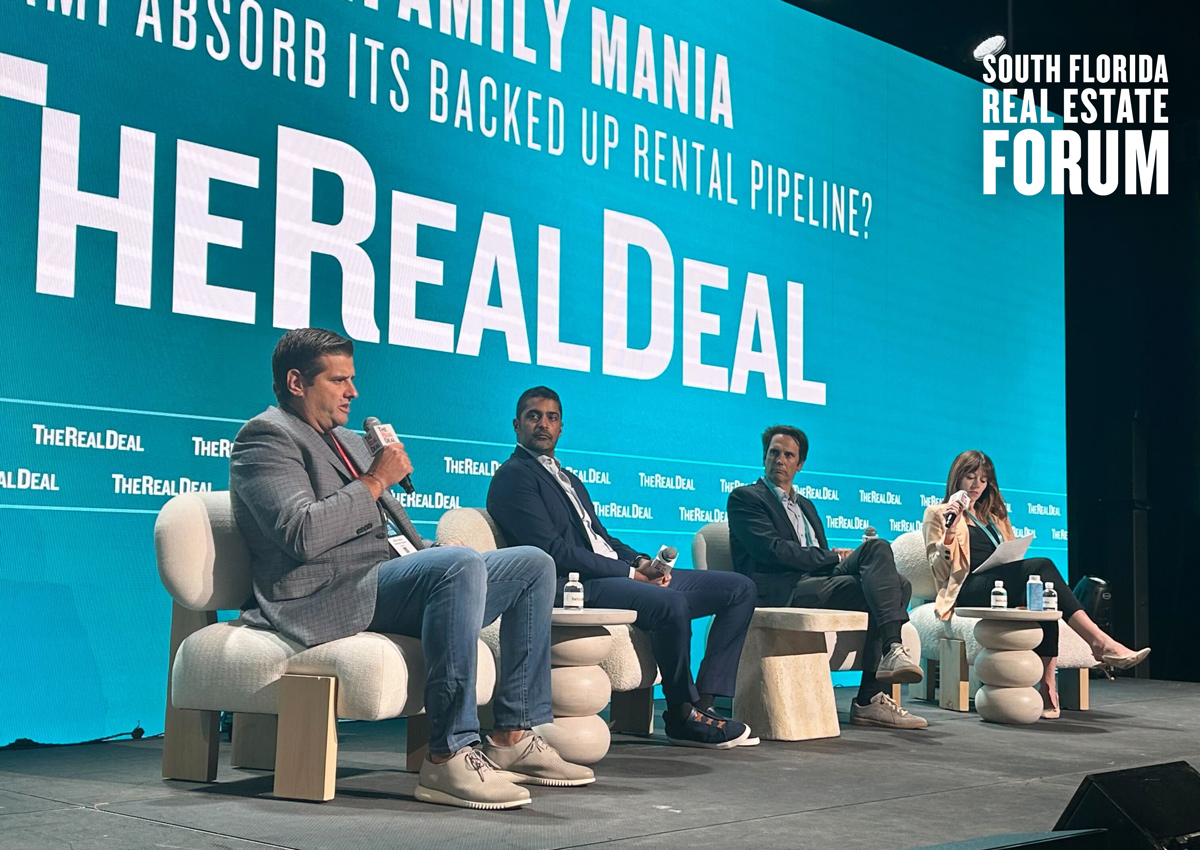South Florida’s multifamily market boomed over the past four years due to an influx of out-of-state residents that led to unprecedented demand and record rent growth. Developers seized on the bonanza with new projects, many of them completed and many more under construction.
But now, the market climate is different.
“Things have slowed down for sure since the pandemic,” developer Inigo Ardid said at The Real Deal South Florida Real Estate Forum on Wednesday.
Building costs have increased faster than inflation, and elevated interest rates have made construction financing more expensive, he said. Lower loan-to-value ratios have necessitated additional equity infusions –– which aren’t easy to secure –– in developments. At the same time, rent growth flatlined due to thousands of newly completed units. By year-end, 23,863 units are expected to be completed, the biggest number since at least 2002, according to a Berkadia report.
Nitin Motwani, managing partner of Fort Lauderdale-based Merrimac Ventures, and Jeff Ardizon, principal of South Miami-based Estate Companies, joined Ardid, co-president of family owned Brickell-based Key International, at the TRD Forum. They headlined the “Multifamily Mania: Can Miami Absorb Its Backed Up Rental Pipeline?” panel moderated by TRD Senior Reporter Suzannah Cavanaugh.
The developers agreed on the general state of South Florida multifamily. Even with explosive development, projects are leasing up. Yet, difficult capital markets led to a pause on construction starts this year. That’s not necessarily bad news. It will allow for newly built units to get leased up, lowering supply and leading to healthy rent growth by late next year and into 2026, they said.
“When you look at what happened in New York a few years ago when everything stopped, they are now at record rents. Not because of anything else, but there was a dramatic loss of supply,” Motwani said. “We are living through that right now.… And as supply decreases, we are going to see a lot of the same boom in rents in South Florida, which will prompt us to move forward.”
Motwani is confident demand will continue, and says usually the CEO first moves to South Florida, and then a wave of employees follow.
“That’s thousands and thousands of higher-paid employees, many of which are coming from urban environments that are looking for multifamily, and others who are looking for a more suburban experience,” Motwani said.
Helping alleviate the hefty apartment supply are condo conversions.
Case in point: At the Miami Worldcenter mixed-use megaproject in downtown Miami, Adam Neumann’s apartment venture Flow launched condo sales of the 466-unit Flow House last month. The 40-story tower originally was conceived as apartments.
“Now you are decreasing the supply of new [apartment] units by 466 units,” said Motwani,
who is also managing partner of Miami Worldcenter Associates, the master developer of Miami Worldcenter.
The panelists also addressed one of South Florida’s most pressing problems: affordable housing. It’s been a yearslong issue that was exacerbated by the influx of New Yorkers and transplants from elsewhere, many of whom kept their out-of-state jobs at incomes outpacing those in South Florida. Miami-Dade’s annual median income is $79,400, 20.6 percent less than New York City’s $97,600, according to the U.S. Department of Housing and Urban Development.
Last year, state lawmakers approved the Live Local Act, giving developers tax breaks and wiggle room on zoning restrictions if they designate at least 40 percent of their projects’ units for households earning no more than 120 percent of the area median income. This year, the legislature also loosened floor area ratio requirements for Live Local projects.
At first, developers were giddy over Live Local. But after examining sites and financials, some found out it’s not a windfall.
“It’s hard to pencil those deals out,” Ardizon said. “I think Live Local in theory was a great concept. If this was four, five years ago, when construction costs were significantly less, it may have worked. And it could work down the road here.”
Live Local allows for taller buildings than permitted under municipal zoning. But development of towers is financially straining, partly due to the higher cost for garages.
“You have great brokers trying to sell sites that have Live Local [development potential],” Ardizon added. “[They are marketing] about an acre, and you are going about 35, 40 stories and hitting about 600 to 700 residences. No one wants to go up. … We have to be responsible in how we approach these deals.”
Counties and municipalities have made strides in helping financials for affordable housing pencil out through additional incentives such as reduced parking requirements, the panelists said. But more help is needed.
“As much as we want to fill in this [affordable housing gap], it’s extremely difficult without having assistance from local municipalities,’ Ardizon said. “We don’t build buildings for free. This is a business.”
Read more
Inigo and Diego Ardid banking on Brickell office tower

Development
South Florida
TRD Forum panelists: The “Citadel effect” is boosting Brickell

How is Flow revolutionary? Adam Neumann: “It’s a feeling”



